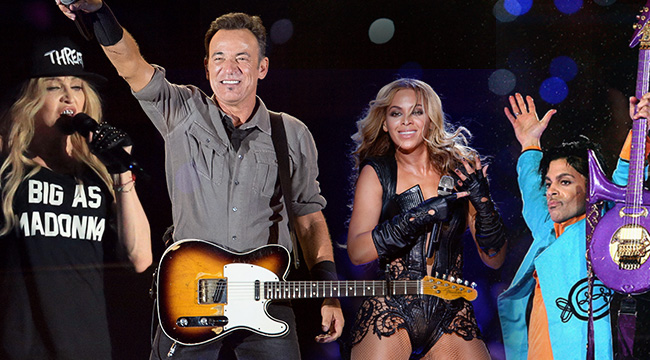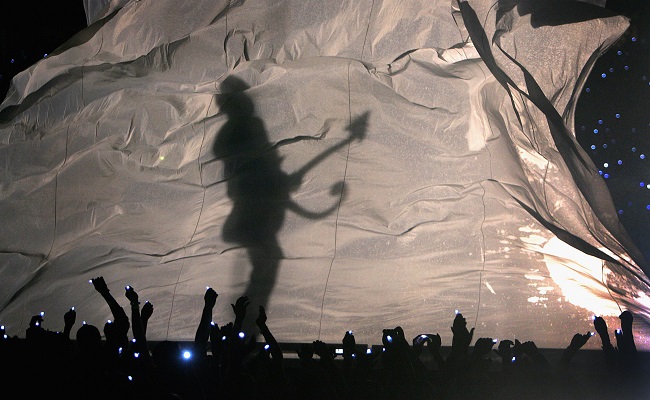
In February of 2004, the Halftime Show at the Super Bowl would be changed for the foreseeable future. One nipple, barely visible to the untrained eye, would spark a tidal wave of outrage and over-reaction. What would follow would be years of safe choices, a few mildly risky choices, and course corrections due in large part to those mildly risky choices. It was the dawning of a new era, the Post NippleGate Era, the most recent era the show has endured.
The Halftime Show at the biggest sporting event of the year has gone through a series of eras. First there was the Marching Band Era (Super Bowls I and II) where the show’s entertainment was college marching bands. The show then transitioned to the First Thematic Era (Super Bowls III through XXIV), when each show had a particular theme, followed by the Second Thematic Era (Super Bowls XXV through XXXVIII), where big name acts were now included in the show’s theme. The Second Thematic Era’s high point was Michael Jackson’s performance at Super Bowl XXVII, which technically didn’t have a theme, but was book-ended by Halftime Shows that did. If anything, you could say the theme of Super Bowl XXVII was “ground-breaking,” because that’s what Jackson’s performance was. Michael’s sister’s performance at Super Bowl XXXVIII in Houston, Texas didn’t just usher in a new safe era, but ended the Second Thematic Era, as her performance capped a Halftime Show that also featured P. Diddy, Kid Rock and Nelly had a theme of “Rock the Vote.”
The cloud of NippleGate, Janet Jackson’s “wardrobe malfunction,” during her duet with Justin Timberlake at the end of Super Bowl XXXVIII’s Halftime Show, would hang over every Halftime Show in the following years. Safe was now the operative word when selecting acts — not relevance or popularity. Starting with Paul McCartney performing the following year at Super Bowl XXXIX, the choice of performers was done in direct response to what happened in Houston. The goal was not so much about entertaining the masses, but trying incredibly hard not to offend them. In the years that followed, occasionally a show would get a little too close to the line, resulting in a course correction the next year.
Looking back at Super Bowl Halftime Shows that occurred during the Post NippleGate era, performances can be ranked on a Safety Scale:
- We totally trust you
- We feel pretty good about this
- Well, your references did check out… so okay
- We’ll need you to sign a few legal things beforehand
- Yeah, we’re going to need see a rehearsal first
2005: Paul McCartney
https://www.youtube.com/watch?v=n3ZHtZqIpXc
I actually kind of feel bad for him here. One of the greatest musicians of all-time was presented simply as “someone who definitely won’t show their boobs.” McCartney’s performance was derided as boring, but I don’t think that was a fair criticism; he was as good as ever. The problem was, we knew *exactly* why he was there, and unless you were a huge Macca fan, it was probably hard to look past that. I’d actually like to see him be invited back in a context where his music would be appreciated more than it was here. – John Hugar
Safety Scale: 1
2006: The Rolling Stones
The Stones played three songs, perched on top of a stage designed to look like their famous lips logo. Two of the three songs are no-brainers- “Start Me Up” and “(I Can’t Get No) Satisfaction.” Yet they sandwiched in “Rough Justice,” the opening track off of their 2005 album, A Bigger Bang, proving that it doesn’t matter who you are, a band is always looking to wedge in something new for you to hear, whether you want to or not. The repercussions from NippleGate loomed over the performance, though, as a five-second tape delay was used as parts of “Start Me Up” and “Rough Justice” were deemed a little too racy in the post Janet Jackson’s exposed nipple world. – Ryan O’Connell
Safety Scale: 2
2007: Prince

So, this was when they decided to take something of a risk. Prince was a music veteran, but he’s never been one to shy away from controversy. Sure enough, the moment where he closed the stage curtains, and used his guitar as a phallic symbol probably ruffled a feather or two in the more uptight circles. Mostly, though, I’ll remember this for being quite possibly the best Halftime Show ever. His cover of the Foo Fighters’ “Best of You” was killer, and it might have even acted as a bit of repayment for their take on “Darling Nikki.” This was a fantastic performance that brought some much-needed energy to the Halftime Stage. And yeah, it was a little bit racy, which was certainly not a bad thing. – JH
Safety Scale: 3
2008: Tom Petty & The Heartbreakers
We’ll chalk this up as kind of a step back and a course correction after Prince’s antics the year before. It’s almost as if the NFL was scolding someone, saying, “Hey, we tried it your way and you blew it. You had to go and pretend your guitar was a penis, Prince.” To be fair, though, there’s nothing wrong with Tom Petty & The Heartbreakers and it could have been worse. The NFL could have dusted off Up With People. It should be noted that as a die-hard Patriots’ fan, I’ve blocked this game from my memory. So, I can’t really say for sure if this was a great performance or not, or if Petty flashed the crowd. I’m assuming he didn’t, though. Not his style. – RO’C
Safety Scale: 1
2009: Bruce Springsteen & The E Street Band
This was basically a continuation of the Petty choice, except with a bigger name. Really, safe or not, the Boss was pretty much the perfect choice for the Halftime Show. Football is often viewed as the quintessential American sport (replacing baseball), and there was no better performer than the Boss. Really, it’s a shame all the instruments are pre-recorded here, because the E Street Band could still slay. Anyway, while certainly enjoyable, this was another ultra-safe choice, and what I’ll probably remember about it most is Bruce awkwardly trying to make the opening line of “Glory Days” about football. – JH
Safety Scale: 1
2010: The Who
https://www.youtube.com/watch?v=ScA2FqJn9ic
At this point, it seemed like this would be standard operating procedure now and that Halftime Shows would be a parade of rock legends, for better or worse. Classic rock radio stations would be consulted as opposed to Top 40 stations. This was not The Who’s finest moment, only made worse by sound problems. Really, the only positive to come from the performance is that it appeared as if it made the NFL rethink its “old rock dudes” policy, as they would veer towards something the kids are into for the next year’s show. – RO’C
Safety Scale: 1
2011: The Black Eyed Peas featuring Usher, Slash
https://www.youtube.com/watch?v=zV4d6Ig1xtA
This will go down in history as the “back to normal” show. Obama had been in office for two years, the country seemed a bit less conservative, and finally, it was time for a contemporary act to play the Super Bowl. So, how dangerous are the Black Eyed Peas? Well, Fergie did pee her pants on stage once, but I doubt that was a *huge* concern for the people putting this one together. If we’re being honest, other than the suggestive lyrics of “My Humps,” the Bar Mitzvah-friendly music of the Peas wasn’t a huge risk. The show itself was nothing special, but we did get a special appearance from Santa Cl- uh, I mean Slash, and at long last the Super Bowl was willing to embrace modern music again. – JH
Safety Scale: 2.5
2012: Madonna featuring LMFAO, Nicki Minaj, M.I.A.
If there ever was a compromise between new school and old school thinking, it was Madonna. No wait, I think we should save that for 2013 and Beyonce’s performance. Tapping Madonna for the Halftime Show was on par with going with the Stones or any of the other vintage rock acts. Madonna may have been bustling with some hype, thanks to the impending release of her album, MDNA, but she was still essentially a classic rock act. And she was a well-known classic rock act, meaning that the NFL knew what they were getting with her. However, the NFL did not know what they were getting with M.I.A., who joined Madonna for “Gimme All of Your Luvin’,” a track off of MDNA, and slipped in a middle finger when no one was looking. Except everyone was looking. So, is Paul Simon available for 2013? – RO’C
Safety Scale: 3
2013: Beyonce featuring Destiny’s Child
Nope, they thankfully stuck with contemporary acts! This was a genius pick for the halftime show, partially because Beyonce gave us the best show since Prince, but also because Beyonce is the type of performer who doesn’t seem safe, but who probably isn’t likely to do anything super-controversial, either. Admittedly, this was before her revelatory self-titled album came out, so there was no risk of her performing provocative songs such as “Drunk in Love,” or “Partition,” so maybe she’d be a riskier choice now. Having her perform with Coldplay seems pretty safe, though. – JH
Safety Scale: 3
2014: Bruno Mars featuring Red Hot Chili Peppers
https://www.youtube.com/watch?v=vV8p4fCOzhw
How do you follow Beyonce? That’s a rhetorical question because you can’t! For starters, you have to build a whole new stage because Bey destroyed it. So, if you are starting over, Bruno Mars seems like a good, solid move. The announcement that Mars would be performing was initially a surprise, prompting numerous versions of the same question: Is he big enough to do that? The last minute addition of the Red Hot Chili Peppers seemed to answer that, in a way saying that Mars couldn’t do the heavy lifting on his own and needed some ringers. Wrong! Bruno Mars crushed it, the Chili Peppers embarrassed themselves and everything we know is wrong. – RO’C
Safety Scale: 1
2015: Katy Perry ft. Missy Elliot, Lenny Kravitz
Ah yes, the Super Bowl that gave us Left Shark. Hard to believe it was just a year ago. Well, Katy Perry has been known to shoot things out of her breasts in music videos, so you can’t say there was no danger here. Still, she’s a not-particularly-controversial contemporary performer whose aesthetic is candy-colored and heavily choreographed. One surprising bit of prudishness here came during her performance of “Teenage Dream,” when the song’s bridge, which includes the line “let’s go all the way tonight” was omitted from the performance. If the organizers really do still care about being safe, one can’t help but wonder if they still would’ve invited Lenny Kravitz after his on-stage incident this past August. – JH
Safety Scale: 2
